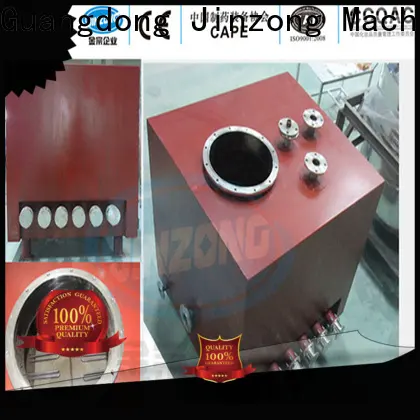Jinzong Machinery | Cosmetic Machinery & Chemical Machinery Manufacturers
New sodium hypochlorite storage tanks factory for distillation
A sodium hypochlorite storage tank is a specialized container designed to safely store sodium hypochlorite, a chemical compound commonly used as a disinfectant and bleaching agent. These sodium hypochlorite tanks are typically constructed from materials that can withstand the corrosive nature of sodium hypochlorite, such as high-density polyethylene (HDPE) or fiberglass-reinforced plastic. Engineered for both safety and efficiency, the sodium hypochlorite storage tank features robust design elements that prevent leaks and spills while facilitating ease of access for monitoring levels and conducting maintenance. Often equipped with integrated level sensors and containment systems, these tanks ensure compliance with environmental regulations by minimizing the risk of overflows or accidental releases into surrounding areas. The careful design considerations also accommodate temperature fluctuations, which can affect the stability of the stored solution, thereby ensuring its efficacy when utilized in various applications ranging from water treatment facilities to industrial cleaning processes.
What is sodium hypochlorite storage tank material?
Fiberglass tanks are the best storage options for sodium hypochlorite if you are looking for a long-term investment. It can last up to 15 years when properly designed, constructed, maintained, and installed. Polyethylene tanks are also viable options and they are as good as fiberglass tanks.
Factors to consider before buying Sodium Hypochlorite storage tank:
• Fiberglass reinforced plastic storages, polyethylene storage tanks, and chlorobutlyl rubber-lined steel storages are the best choices for it.
Even high-density polyethylene tanks are also popular choices among the manufacturers because they are robust, durable and have a specific gravity of 1.9 to offer resilience to corrosion.Fiberglass tanks are the best storage options for sodium hypochlorite if you are looking for a long-term investment.
It can last up to 15 years when properly designed, constructed, maintained, and installed. Sodium hypochlorite poly tanks are also viable options and they are as good as fiberglass tanks. They are known for their molecular weight and tensile strength.
• Avoid steel storage tanks as they are incompatible with bleach. It is because they tend to degrade when the chemicals are stored in them.
• Tanks equipped with in-built secondary containment and catchment basin are especially useful. It will prevent the leakage of the hazardous chemical in bulk quantities.
• Sodium hypochlorite tanks that are reinforced with linings are a feasible option for storing sodium hypochlorite. The linings will protect the container from getting exposed to corrosive activities of the solution that can lead to contamination of iron and structural damage.
• Besides linings, it is also essential to opt for corrosion-resistant and semi-flexible piping, fitting, and gasket materials to shield the chemical contents from sunlight, ozone, weathering, and permeation.
It also acts as a backup when there is a tank failure. It is mandatory for the secondary containment to be chemically resistant and have the capacity to hold 110% of total system fluid capacity when the tank becomes loaded with contents.
• The best component materials for sodium hypochlorite storage tank comprise PVC/CPVC pipes and titanium encapsulated bolts. You can also consider PTFE, PVDF, FKM, and tantalum.
• The storage system should be vented to prevent the accumulation of oxygen off-gassing of NaOCl. The size of the venting should be twice of the inlet pipe diameter.
• While assessing the storage vessels, it is important to keep in mind the concentration strength of the chemical compound.
| Model NO. | JZ-H36 | Capacity | 500L/1000L/2000L Electric Heating Hot-Water Heater |
| Power | 36kw or Customer Design | Material | Carbon Steel/Stainless Steel |
| Trademark | Jinzong Machinery | Transport Package | Plywood Case |
| Specification | CE, SGS, ISO9001 | Origin | Guangdong |
*Product details:
1> Capacity: 1000 litre.
2> Internal layer Material and wall thickness: Stainless steel SUS304, thickness is 3mm.
3> Insulating layer: covered A3 steel, thickness is 3 mm.
4> Heat Power: 48 KW.
5> Equipped with stainless steel centrifugal pump
*MOQ: 1 set
*1000 Litre electric heating hot-water tank,hot water heater for cosmetic Packing:
1> Outer packing: plywood case
2> Inner packing: PE film wrapping overall
*1000 Litre electric heating hot-water tank,hot water heater for cosmetic Shipping:
FOB port: Guangzhou or Shenzhen
*1000 Litre electric heating hot-water tank,hot water heater for cosmetic After-sales service:
1> one year from date of delivery, if any spare parts be broken within warranty and not caused by improperly operation, we would offer the new parts for free.
2> Provide professional after-sales service engineers to abroad installation and debugging.
*About us:
We are a professional manufacturer of cosmetic,chemical& pharmaceutical machinery and equipment more than 17 years .Product lines range from:
1> Cosmetic Machinery: water treatment ,vacuum emulsifying machine,liquid detergent mixing machine,storage tank,solid soap making machine,perfume making machine, filling machine etc.
2> Chemical Machinery: reactor, mixing equipment,separation equipment, storage tank etc.
3> Pharmaceutical Machinery: vacuum ointment machine,sanitary stainless reaction pot,alcohol deposition can, collocation tank etc.
*Why Choose Jinzong Machiney?
1. More than 17 years in Cosmetic and cheimical industry
2. Quality, 80% materials and components are purchased from 3M, ABB, Siemens, Panasonic, Schneider
3. Good reputation in industry.
4.Have a Professional after-sales service engineering team
5.Large scale and strong strength
Tel: +86-758-3623881
E-mail: sales@jinzong.com.cn
Fax: +86-758-3623880
Address: NO.3 Kangtai St., Hi-tech Dist., Zhaoqing City, Guangdong Province, China(526238)


